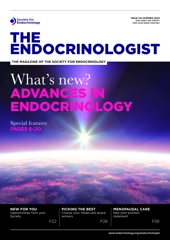The effects of the COVID-19 pandemic continue to be felt throughout healthcare systems around the world. Although efforts remain focused on managing the acute effects of the infection, long COVID is increasingly recognised as a complication of even mild infection with SARS-CoV-2.
Estimates suggest that 1.5 million people in the UK have experienced symptoms of COVID beyond 4 weeks after initial infection. Of these, 71% have experienced symptoms for at least 12 weeks.1 Fatigue is most frequently reported, alongside hair loss, reduced libido, menstrual irregularity and palpitations, and so there is considerable overlap with symptoms of endocrine dysfunction. The endocrine system is vulnerable to disruption by COVID-19, both due to the nature of the precise vascular supply to endocrine glands, and because several endocrine glands possess the receptor (ACE2) and protein (TMPRSS2) needed for the SARS-CoV-2 virus to access cells.
THYROID EFFECTS
'Estimates suggest that 1.5 million people in the UK have experienced symptoms of COVID beyond 4 weeks after initial infection. Of these, 71% have experienced symptoms for at least 12 weeks.'
One of the more frequently encountered changes to endocrine function in patients with acute COVID-19 is thyroid dysfunction. Non-thyroidal illness (NTI), characterised by global reductions in thyrotrophin (TSH), free tri-iodothyronine (fT3) and free thyroxine (fT4), affects up to 7% of patients with mild–moderate acute COVID-19.2 It occurs due to a reduction in hypothalamic TSH-releasing hormone and is observed at times of physiological stress.
In a smaller proportion of patients, subacute thyroiditis and autoimmune thyroid dysfunction (Graves’ disease) have also been observed in cases of COVID-19. However, there is currently no evidence demonstrating persistent thyroid dysfunction in patients with long COVID. Indeed, in patients at 12 weeks’ follow up, thyroid function was not different in those with fatigue compared with those without.3
ADRENAL FUNCTION
Recently, histopathological evidence of adrenal gland destruction has been presented from patients who died from COVID-19. One group observed adrenal inflammation, widespread microthrombosis and reduction of cortisone intensities,4 whilst another demonstrated the SARS-CoV-2 spike protein in adrenocortical cells, as well as SARS-CoV-2 mRNA.5 Case reports of adrenal haemorrhage and adrenal infarction have also been reported in patients presenting with adrenal insufficiency after COVID-19.
Yet, current evidence suggests that, for the majority of patients, adrenal function is preserved after COVID-19 infection. We observed a normal cortisol response following administration of Synacthen (tetracosactide) to patients who survived COVID-19, even in those with persistent fatigue 12 weeks after initial infection.3 Additionally, although a minority had dehydroepiandrosterone sulphate (DHEAS) values below the age and sex reference range, DHEAS was not different in those who were tired, compared with those who were not, further reflecting preserved adrenal function in patients who survive COVID-19.6 Whilst national data are yet to be collated, this confirms clinical experience; we are not encountering the significant numbers of patients with adrenal insufficiency that we might expect, were adrenal damage a frequent complication of COVID-19.
REPRODUCTIVE IMPACT
'There remains little evidence to suggest that endocrine disruption contributes to the syndrome of long COVID, although large scale studies remain to be undertaken.'
The reproductive system is inherently vulnerable to disruption by systemic illness. There has been focus on the impact of COVID-19 on the hypothalamic–pituitary–gonadal axis. Ovarian ACE2 mRNA has been detected in both pre- and post-menopausal women, as well as in the endometrium. Furthermore, ACE2 regulates angiotensin, which helps facilitate regulation of oocyte maturation and corpus luteum maintenance.
Patients with mild COVID-19 reported prolonged cycle length, and serum anti-müllerian hormone levels were lower in patients with COVID-19, compared with controls.7 However, there are multiple factors that may contribute to disruption of the hypothalamic–pituitary–gonadal axis, including psychological stress – a significant factor for many individuals during the pandemic. To date, however, there is no evidence that COVID-19 results in persistent perturbation of menstrual regularity.
The male reproductive tract possesses ACE2 receptors, specifically in the Leydig and Sertoli cells.8 Additionally, patients with COVID-19 have been observed to have both acute and subacute orchitis. In a seven-month follow-up study of 121 patients, total testosterone was observed to increase significantly compared with baseline on admission, although, interestingly, 55% of patients were hypogonadal. However, total testosterone at seven months’ follow up was associated with co-morbidities, suggesting that factors other than COVID-19 were influencing testosterone values at this time.9
METABOLIC EFFECTS
Finally, perhaps one of the most frequent endocrine disturbances experienced during the pandemic is that of hyperglycaemia and ketosis, even in patients not known to be diabetic. SARS-CoV-2 viral mRNA has been detected in the β cells of patients with COVID-19 at autopsy, and autoantibody-negative type 1 diabetes and insulinopenia have been reported acutely in patients with COVID-19. Additionally, at 6 months after admission, more than a third of patients who were observed to have hyperglycaemia during their acute admission had persistent hyperglycaemia and ~2% had new-onset diabetes.10 However, in our cohort, C peptide values were preserved at three months of follow up,11 and others have shown that it is significant insulin resistance that predominantly contributes to the insulin insufficiency observed.12
IN SUMMARY
The endocrine system is vulnerable to disruption by the SARS-CoV-2 virus. Whilst the focus is now shifting from the effects of acute infection to prolonged and persistent effects, there remains little evidence to suggest that endocrine disruption contributes to the syndrome of long COVID, although large scale studies remain to be undertaken.
Sophie Clarke
Consultant Endocrinologist, University College London Hospital
REFERENCES
1. Ayoubkhani D et al. 2021 Office of National Statistics www.ons.gov.uk/ peoplepopulationandcommunity/healthandsocialcare/conditions anddiseases/bulletins/prevalenceofongoingsymptomsfollowing coronaviruscovid19 infectionintheuk/7october2021.
2. Lui DTW et al. 2021 Journal of Clinical Endocrinology & Metabolism 106 926–935.
3. Clarke SA et al. 2021 Journal of Clinical Endocrinology & Metabolism 106 2208–2220.
4. Paul T et al. 2022 Nature Communications 13 1589.
5. Kanczkowski W et al. 2021 Lancet Diabetes & Endocrinology 8587 19–21.
6. Clarke SA et al. 2022 Clinical Endocrinology In Press.
7. Ding T et al. 2021 Frontiers in Medicine 8 1–11.
8. Ma X et al. 2021 Cellular & Molecular Immunology 18 487–489.
9. Salonia A et al. 2022 Andrology 10 34–41.
10. Montefusco L et al. 2021 Nature Metabolism 3 774–785.
11. Clarke SA et al. 2022 Diabetes, Obesity & Metabolism 24 570–574.
12. Li J et al. 2020 Diabetes, Obesity & Metabolism 22 1935–1941.






